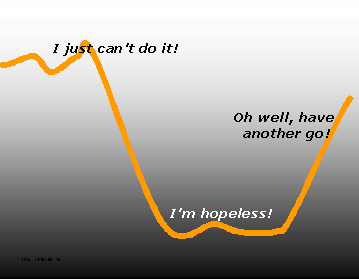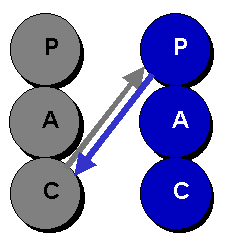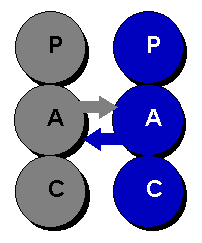Tutoring 4
Implications of an Oscillation model
As the discussion of the "Skeleton and Shell" model suggests, you can only oscillate effectively if the poles between which you oscillate are defined (which is not to suggest of course that you necessarily go as far the poles themselves). If the system does not admit of the existence of a pole, all you can get is an uncontrolled retreat from the other one when you can't take it any more.
Thus instead of Figure 2, you end up with something like the "catastrophic oscillation" in the Skeleton and Shell model, which, represented with the conventions of this paper, appears as:

Figure 8
(The shaded black background in this figure indicates that the reflective environment is simply absent)
The learner, being a resilient and gutsy sort of person in this example (otherwise she would just stay at the bottom and not try again), is forced to have another go without the benefit of support and reflection, and is thus restricted to simple trial-and-error learning because Reflective Observation and Abstract Conceptualisation are by-passed. These disciplined stages are swamped by the affective processes of despair and possibly "pick yourself up, dust yourself off, and start all over again". Note, of course, that while we are discussing this model in the context of the tutor providing the reflective environment, an accomplished "independent" learner may be able to provide this for herself.
If you are odd enough to have read other stuff on this site, you will of course recognise a resemblance to the trough of problematic supplantive learning (PSL) in Figure 8: this is not accidental, but PSL is a special case which makes special demands.
It is possible to conceive of the alternative scenario in which the denied pole is that of Action. This leads to reflection which never results in action, but merely in the fruitless proliferation of useless ideas. I leave it to the reader to decide whether I am caught in this trap!
The message is simply that a model of teaching-learning which denies either pole is dysfunctional. Thus if andragogy or other humanistic models of teaching-learning deny the reflective/receptive pole, as they may in the hands of half-baked practitioners, they don't work.
But not all variations of the establishment of the poles and oscillation process are equal. Maiteny and Reed (1998) speak of "dysfunctional" regression to dependence. Heron (1990) refers to the possibility of "degenerate" interventions in the helping process. In both cases there is a recognition that superficially the same process can be used in a way which either contributes to the overall effectiveness of a system, or hinders it. (See note)
There are many ways of inducing the reflective/receptive stage in the tutorial process. They include on the one hand adopting the values of andragogy, within a realistic framework � and on the other, intimidation and humiliation.
If you want to go down the intimidation and humiliation route, that is up to you. This discussion will concern itself more with other approaches to inducing receptiveness.
Another framework
Let us bring in here another framework (as if we did not have enough�but they are all different perspectives on the same phenomena, drawing attention to different things).
See also "Frames of Reference"
This is Transactional Analysis. Berne (1966) draws attention to the power imbalance between the client and the psychotherapist in the therapeutic or counselling encounter�which is not a million miles from the tutorial, since both are task-based individual or small group meetings in which one person has authority by dint of training, experience, position and role. Indeed, TA was developed in part in order to counter the "one-down" position of the client, by giving him a shared language with the therapist.
TA has two ways of exploring the process of this relationship. The first is the "I'm OK�You're OK" theory of "life positions". Without going into detail, Berne maintains that the default assumption in counselling and therapy (and tutorials) is that the client/student is "Not OK" while the therapist/tutor is "OK". This, he argues, inhibits effective work and needs to be countered. Only the "I'm OK� You're OK" position is acceptable.
The second TA angle comes from the famous Parent-Adult-Child model. Again, I will skip the detail, but TA suggests that we each have three "ego-states", of Parent (seat of internalised values, from our own parents); Adult (rational and here-and-now oriented); and Child (the remnants of the child each of us once was). TA maps the potential interactions between the ego-states of any two people encountering each other, usually diagramatically.
I was once, in the 1970s, a great fan of TA, and even started training as a TA therapist: now I am suspicious about the whole "therapy" culture. TA is probably one of its more benign if ineffectual manifestations...
Learner/Client Tutor/Therapist
TA maps the default relationship between (in our case) tutee and tutor as a Child-Parent relationship. This suggests that the tutee is inclined to defer to the tutor's definition of the situation and to her values. This makes for a relatively easy relationship, and is of course reinforced by the fact of the tutor's authority within the educational system, and perhaps by her role as an assessor.
 However, TA suggests that being in the Child ego-state is not
conducive to the tutee learning. As far as TA is concerned, the
ability to learn is the prerogative of the Adult ego-state. It is
therefore necessary to establish an Adult-Adult relationship for
learning to take place. (Both Parent-Child and Adult-Adult are relatively
stable relationships in TA terms: other variants are less stable).
However, TA suggests that being in the Child ego-state is not
conducive to the tutee learning. As far as TA is concerned, the
ability to learn is the prerogative of the Adult ego-state. It is
therefore necessary to establish an Adult-Adult relationship for
learning to take place. (Both Parent-Child and Adult-Adult are relatively
stable relationships in TA terms: other variants are less stable).
The Parent-Child pattern may result in compliance, but only Adult-Adult results in learning.
This Adult-Adult relationship is of course consistent with the ideas of andragogy.
If you are looking for a simple, rule-of-thumb guide to the tutorial relationship, the TA model is as good as any. But it is basically static, and the discussion so far has suggested a dynamic and oscillating situation. Moreover, it is all very well to specify how things ought to be, and it may be relatively easy for the tutor to stay in Adult, but simply telling a tutee not to go into Child is at best unreliable, and can indeed be counter-productive. (Having said that, if you can recognise the non-verbal signs, such as not making eye-contact, and muttering rather than speaking with animation, you may be able to address them.)
Containment
I want to argue that a necessary (if not entirely sufficient) condition of facilitating effective and authentic receptiveness/reflection lies in the understanding and authentic practice of what that notoriously cerebral and obscurantist psychoanalytic theorist Wilfred Bion called "containment".
Bion's (1970) concern was the relationship between an institution or group and its members (particularly the difficult member, whom he called the "mystic"), from which he articulated a more general principle�the relationship between the container and the contained. This, he argued, could take three forms:
- commensality
- parasitism
- symbiosis
�which of course parallel the potential relations between species in ecological systems.
Commensality simply means "dining from the same table": the two elements (container and contained) co-exist in parallel, "and the existence of each can be seen to be harmless to the other" (Bion, 1970:78). It is not very interesting, but if it happens in the tutorial situation, tutor and learner have effectively not made contact.
Parasitism exists in two forms. In each, one element exploits, consumes and potentially destroys the other.
- The container (tutor) can parasitise the contained (learner). This is what happens when the tutor imposes her understanding on the learner, denying and invalidating the learner's understanding and insights, and seeking to produce "graduates" who are clones of herself. This happens in the case of charismatic and/or dogmatic tutors who impose (wittingly or unwittingly) their views on "their" learners. Think of Miss Jean Brodie or leaders of cults.
- The contained (learner) can parasitise the container (tutor). This is what happens when:
- The tutor denies her authority and expertise in a mistaken attempt to support the learner. It all end in tears when you get to summative assessment with its checks and balances and external scrutiny.
- The learner demands "answers" from the tutor in such a way as to by-pass his own problem-solving, and consequently becomes unrealistically dependent. We call it a demand for "spoon-feeding".
Antony Smith, Review of Steiner's "Lessons of the Masters" THES No.1,619 12 Dec. 2003 p.31
Symbiosis, in Bion's terms, means "there is a confrontation and the result is growth-producing" (Bion, 1970: 78). This sounds ideal, and indeed it is the consummation devoutly to be wished, but even so there are two dangers (here I go beyond Bion):
- The first is to mistake mutual parasitism for true symbiosis. The tutor imposing her vision (wittingly or unwittingly) and the learner seeking answers fit together well: but there is no real "confrontation" and the resultant "learning" is superficial. Many years ago, a mentee of Reed (of Reed and Maiteny) told me that he had "great undigested lumps of Bruce Reed" inside him. I can testify to precisely the same experience, although we both moved beyond it.
- The second is when the genuine symbiotic fit is too close.
The process works very well, but�deprived of the tutor or mentor�the
learner has not internalised the process. Without her "sparring
partner" she is lost. It is a kind of complacency which
leads to a rude awakening, and it is a real problem in the context
of courses which students will complete, and then find themselves
without this external sparring partner. My apologies for describing Donald
Winnicott as just "another psychoanalyst". Winnicott
(1970), another psychoanalyst, emphasises the importance
of the failure of the "good-enough" mother
to respond at once to the demands of her infant, as the way
in which "potential space" is created to enable the
child to grow and learn. The same is true of the tutor.
- To adopt another of Bion's ideas�there comes a point at which instead of mobilising sophisticated or mature dependence, the tutor may need to mobilise appropriate flight. (Kick them out of the nest.)
So what?
The bottom line is to confirm what you knew all along, but to give it a respectable pedigree. Effective tutoring�defined as the "enabling people to learn" bit of teaching as opposed to the "delivering new information" bit�requires the respectful exercise of appropriate authority.
Neither the denial of learner autonomy nor the denial of dependence work. The model is not a static, either-or situation as it is so often presented. It is both-and. But that in its turn is not a wishy-washy something-in-between compromise, but a dynamic process of oscillation over time, moving in and out of autonomy and dependence, activity and reflection. The tricky bit is managing it, and the timing. The tutor is the manager of the process, but the skilful tutor is always reading the situation to know when the students are ready, and hence when to make the move.
No�since you ask�I don't get it right all the time either! Particularly when I am under pressure or tired, I tend to short-cut the reflective/receptive bit: the students go away happy, but they have not always learned much.

